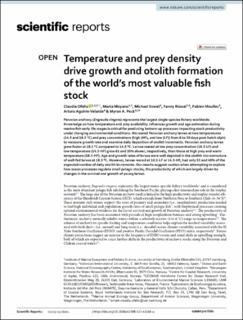Temperature and prey density drive growth and otolith formation of the world's most valuable fish stock
Ofelio, Claudia; Moyano, Marta; Sswat, Michael; Rioual, Fanny; Moullec, Fabien; Aguirre Velarde, Arturo; Peck, Myron A.
Peer reviewed, Journal article
Published version

View/
Date
2023Metadata
Show full item recordCollections
- Publikasjoner fra Cristin - NIVA [2170]
- Scientific publications [1177]
Abstract
Peruvian anchovy (Engraulis ringens) represents the largest single-species fishery worldwide. Knowledge on how temperature and prey availability influences growth and age estimation during marine fish early life stages is critical for predicting bottom-up processes impacting stock productivity under changing environmental conditions. We reared Peruvian anchovy larvae at two temperatures (14.5 and 18.5 °C) and prey concentrations [high (HF), and low (LF)] from 6 to 30 days post-hatch (dph) to measure growth rate and examine daily deposition of otolith increments. Peruvian anchovy larvae grew faster at 18.5 °C compared to 14.5 °C. Larvae reared at low prey concentration (18.5-LF) and low temperature (14.5-HF) grew 61 and 35% slower, respectively, than those at high prey and warm temperature (18.5-HF). Age and growth rates of larvae were well depicted in the otolith microstructure of well-fed larvae at 18.5 °C. However, larvae reared at 18.5-LF or 14.5-HF, had only 55 and 49% of the expected number of daily otolith increments. Our results suggest caution when attempting to explore how ocean processes regulate small pelagic stocks, the productivity of which are largely driven by changes in the survival and growth of young larvae.
